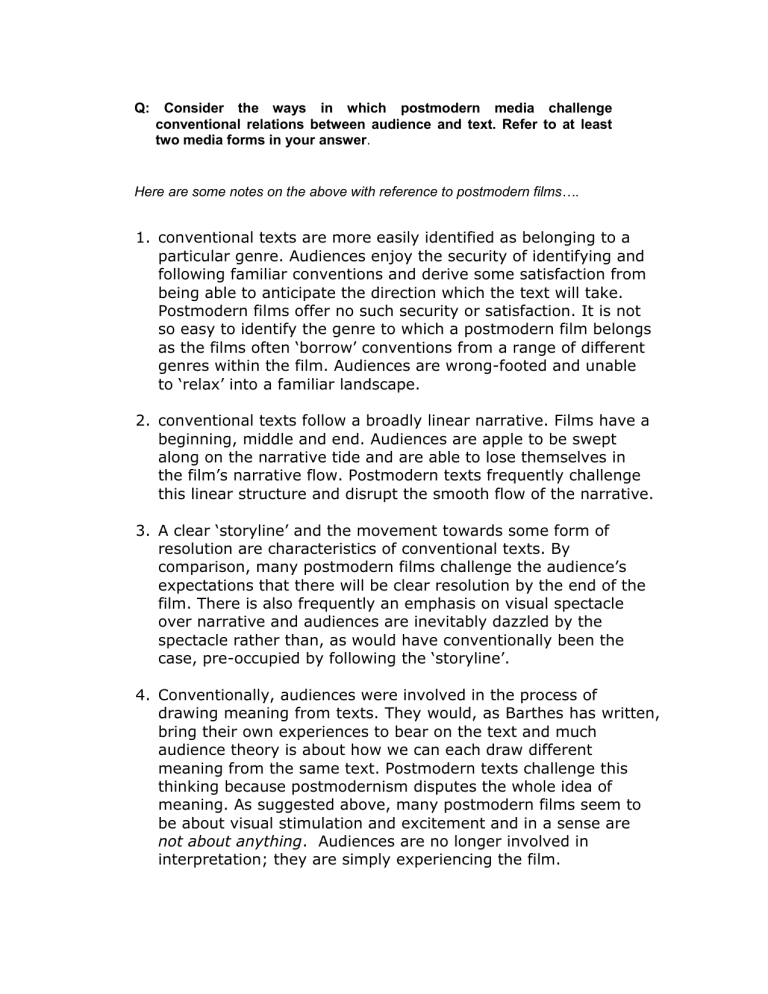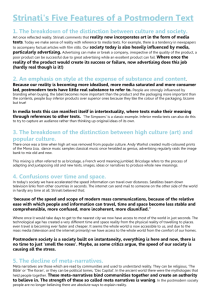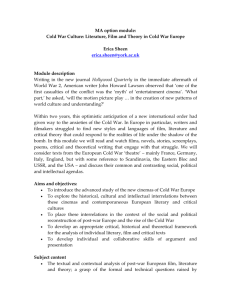Essay Plan

Q: Consider the ways in which postmodern media challenge conventional relations between audience and text. Refer to at least two media forms in your answer .
Here are some notes on the above with reference to postmodern films….
1.
conventional texts are more easily identified as belonging to a particular genre. Audiences enjoy the security of identifying and following familiar conventions and derive some satisfaction from being able to anticipate the direction which the text will take.
Postmodern films offer no such security or satisfaction. It is not so easy to identify the genre to which a postmodern film belongs as the films often ‘borrow’ conventions from a range of different genres within the film. Audiences are wrong-footed and unable to ‘relax’ into a familiar landscape.
2.
conventional texts follow a broadly linear narrative. Films have a beginning, middle and end. Audiences are apple to be swept along on the narrative tide and are able to lose themselves in the film’s narrative flow. Postmodern texts frequently challenge this linear structure and disrupt the smooth flow of the narrative.
3.
A clear ‘storyline’ and the movement towards some form of resolution are characteristics of conventional texts. By comparison, many postmodern films challenge the audience’s expectations that there will be clear resolution by the end of the film. There is also frequently an emphasis on visual spectacle over narrative and audiences are inevitably dazzled by the spectacle rather than, as would have conventionally been the case, pre-occupied by following the ‘storyline’.
4.
Conventionally, audiences were involved in the process of drawing meaning from texts. They would, as Barthes has written, bring their own experiences to bear on the text and much audience theory is about how we can each draw different meaning from the same text. Postmodern texts challenge this thinking because postmodernism disputes the whole idea of meaning. As suggested above, many postmodern films seem to be about visual stimulation and excitement and in a sense are
not about anything. Audiences are no longer involved in interpretation; they are simply experiencing the film.
5.
Conventionally, audiences indulge in what the poet, Samuel
Taylor Coleridge described as ‘the willing suspension of disbelief’.
This means that we put to one side the knowledge that what we are reading or watching is ‘made up’. We allow ourselves to believe. In postmodernist films, characters step outside the film’s diegesis (the world of the film) and address us directly.
Characters also refer to the film that they are appearing in, commenting on it and drawing attention to (rather than concealing) the fact that it is a constructed reality. This selfreflexiveness challenges the illusion which is at the heart of conventional text-audience relations.
6.
Postmodern texts are not self-contained in the sense that they rely heavily on references to and parodies of other texts. This intertextuality often relies on audiences’ knowledge of other texts. Postmodern films therefore make different demands on their audiences…
7.
The ‘flattening of affect’ (Jameson) in postmodernism strips texts of their emotional impact. Conventionally, audiences would be
manipulated by the film-maker into feelings of sympathy or empathy for certain characters. In postmodern texts we are not invited to engage emotionally with characters and the lives portrayed are often cold/emotionless.
You need to decide which texts you want to refer to. You do not need to limit yourself to two but you need to go into a reasonable of detail so it is probably best to impose some limit on yourself.








